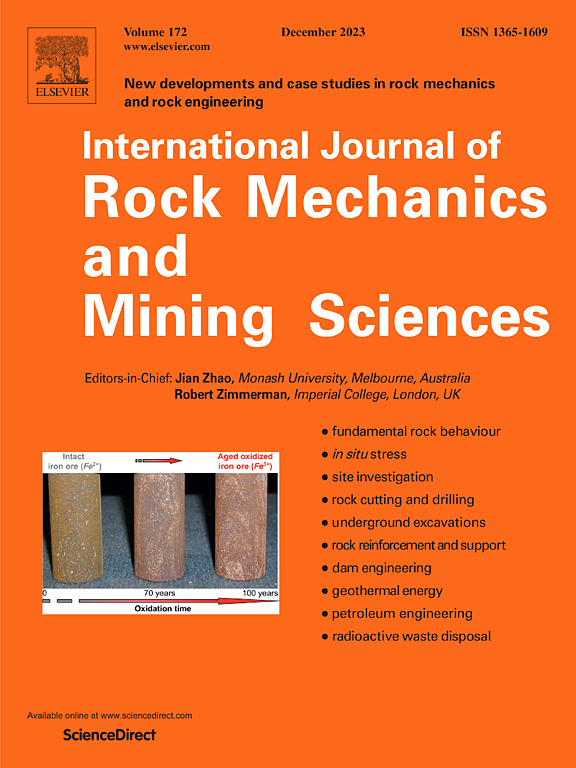基于粘塑性界面元和移岩策略的隧道围岩剥落数值模拟
IF 7
1区 工程技术
Q1 ENGINEERING, GEOLOGICAL
International Journal of Rock Mechanics and Mining Sciences
Pub Date : 2025-04-24
DOI:10.1016/j.ijrmms.2025.106096
引用次数: 0
摘要
岩石剥落是在高地应力状态下,在坚硬岩石中开挖的隧道周围发生的脆性破坏过程。在核废料处理中,破碎的结晶岩石的剥落可以形成连接的裂缝,可能为放射性核素提供通道。因此,需要可靠的数值模型来评估岩石剥落的程度,以便对未来的深部地质储库进行优化设计和布局,使其符合目的。考虑到这一动机,本研究提出了一种基于零厚度界面单元的岩石剥落数值分析方法,该方法具有粘塑性断裂本构律,并结合有限元移除/开挖工作流程。为了模拟剥落,在岩体内沿任意方向的足够数量的网格线预先插入零厚度界面单元。形成均匀的初始应力状态,通过去除相应的单元进行圆隧道开挖,导致部分界面应力超过弹性极限,形成粘塑性裂缝开口。建立了完全被失效界面包围的块体完全脱离或沿运动允许路径滑出网格的条件下,隧道周围有限元开挖的判据。砌块的开挖引起隧道周围的应力重新分布,这导致需要新的开挖步骤,直到达到新的平衡配置。所提出的方法被应用于加拿大原子能有限公司(AECL)地下研究实验室在Lac du Bonnet花岗岩中进行的矿山实验中评估岩石剥落。分析的重点是了解导致脆性破坏的机制和影响因素,并校准材料性能以重现隧道的最终应力状态及其剥落深度。本文章由计算机程序翻译,如有差异,请以英文原文为准。
Numerical modeling of rock spalling around a tunnel using visco-plastic interface elements and a rock removal strategy
Rock spalling is a brittle failure process that occurs around tunnels excavated in hard rock under high in-situ stress states. In nuclear waste disposal, spalling in fractured crystalline rock could create connected fractures, potentially providing pathways for radionuclides. Robust numerical models are therefore needed to evaluate the extent of rock spalling so that the design and layout of a prospective deep geological repository can be optimized and made fit for purpose. With this motivation in mind, this study proposes a methodology for the numerical analysis of rock spalling based on zero-thickness interface elements with a visco-plastic-fracture constitutive law, combined with a workflow for finite element removal/excavation. To simulate spalling, zero-thickness interface elements are pre-inserted along a sufficient number of mesh lines with random orientation within the rock mass. A uniform initial stress state is generated and the excavation of the circular tunnel is performed by removing the corresponding elements, which leads to stresses in excess of the elastic limit in some of the interfaces, and subsequent visco-plastic fracture openings. A criterion for excavation of the finite elements around the tunnel is established when a block which is totally surrounded by failed interfaces is totally detached or can slide off the mesh following a kinematically admissible path. The excavation of blocks causes a stress redistribution around the tunnel and this leads the need for new excavation steps, until a new equilibrium configuration is reached. The proposed methodology is applied to assess rock spalling in the Mine-by Experiment at the Atomic Energy of Canada Limited’s (AECL’s) Underground Research Laboratory in the massive Lac du Bonnet granite. The focus of the analysis is to understand the mechanisms and the influencing factors that lead to brittle failure, and to calibrate material properties to reproduce both the final stress state of the tunnel and its spalling depth.
求助全文
通过发布文献求助,成功后即可免费获取论文全文。
去求助
来源期刊
CiteScore
14.00
自引率
5.60%
发文量
196
审稿时长
18 weeks
期刊介绍:
The International Journal of Rock Mechanics and Mining Sciences focuses on original research, new developments, site measurements, and case studies within the fields of rock mechanics and rock engineering. Serving as an international platform, it showcases high-quality papers addressing rock mechanics and the application of its principles and techniques in mining and civil engineering projects situated on or within rock masses. These projects encompass a wide range, including slopes, open-pit mines, quarries, shafts, tunnels, caverns, underground mines, metro systems, dams, hydro-electric stations, geothermal energy, petroleum engineering, and radioactive waste disposal. The journal welcomes submissions on various topics, with particular interest in theoretical advancements, analytical and numerical methods, rock testing, site investigation, and case studies.

 求助内容:
求助内容: 应助结果提醒方式:
应助结果提醒方式:


